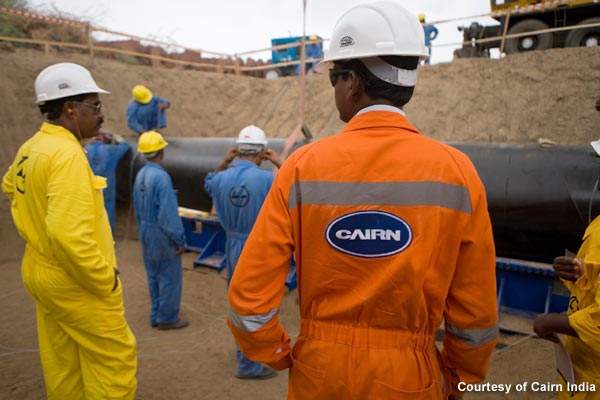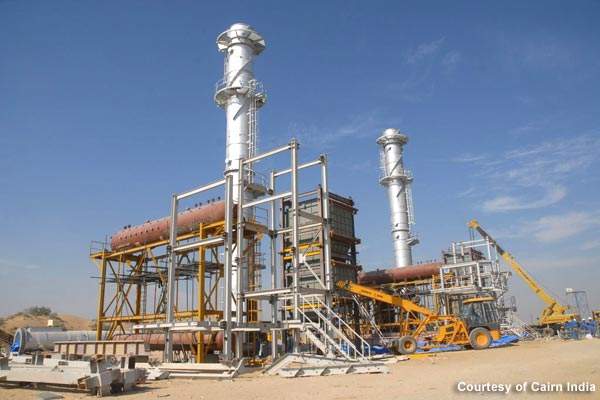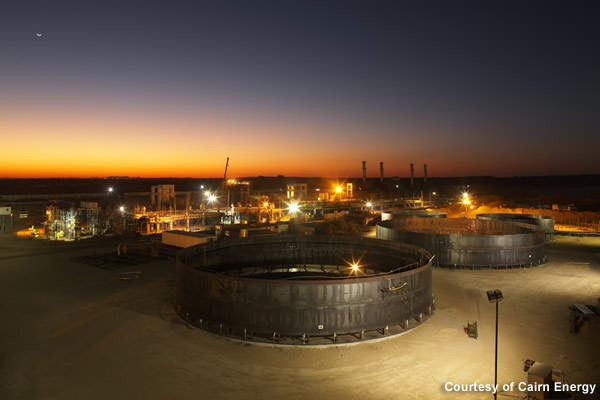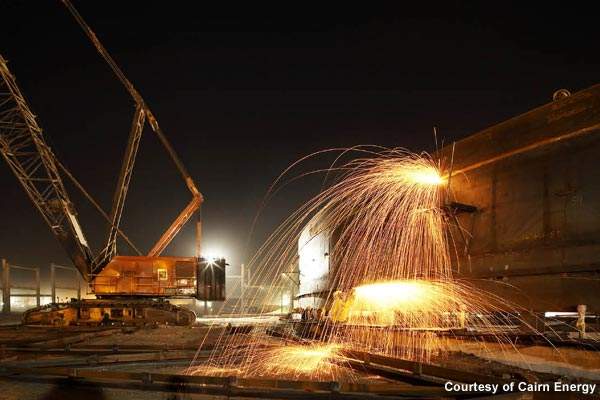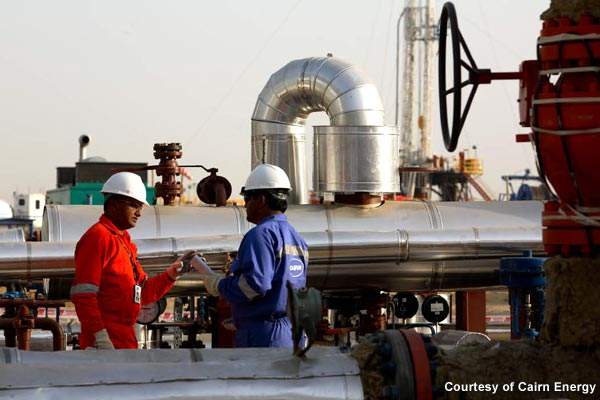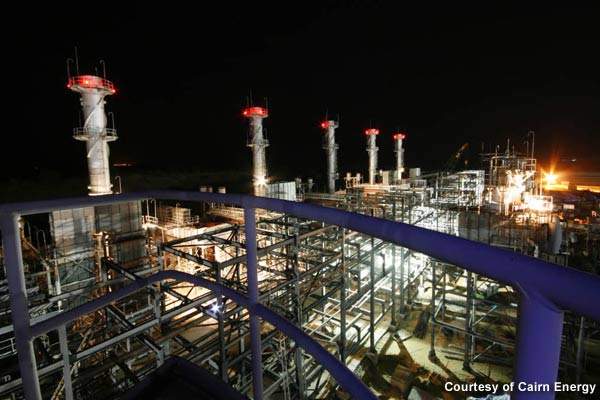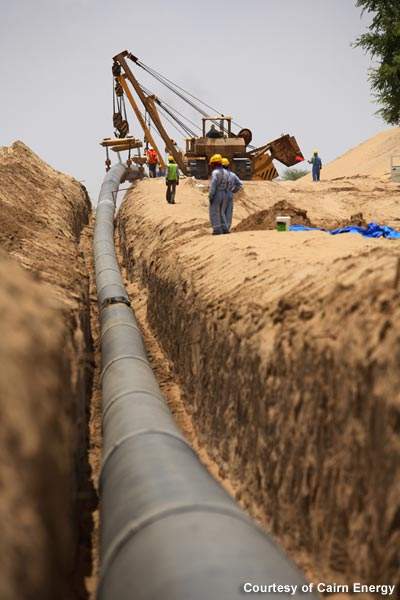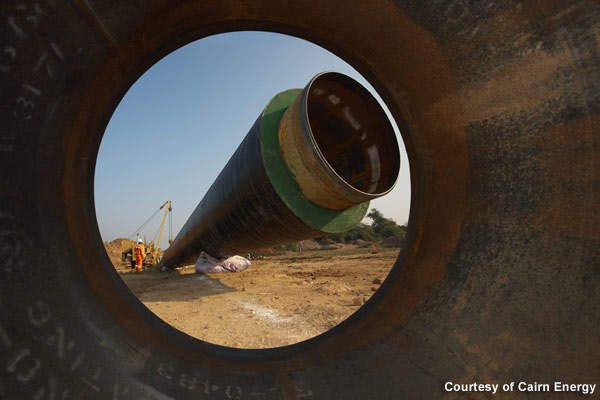Cairn India (CIL), a subsidiary of UK-based Cairn Energy, started production of oil from its Mangala oilfield in Barmer district of Rajasthan in September 2009. The initial capacity of the field was 30,000bpd of oil.
The Mangala oilfield is part of the Rajasthan block RJ-ON-90/1 which is being developed by CIL. CIL holds a 70% participating interest in the Rajasthan block, which covers an area of 3,111km².
Oil and Natural Gas Corporation of India (ONGC) holds a share of 30% in the block.
The joint venture has spent $2bn on the project and plans to invest another $1.8bn by 2011.
The Mangala oilfield is estimated to have 1.1 billion barrels and recoverable reserves of 256-380 million barrels. An additional 100 million barrels can be produced using enhanced oil recovery techniques.
Plateau production from Mangala is estimated to hit 175,000bpd by 2011-12.
Oil from the Mangala oilfield is transported to Mangalore Refinery and Petrochemicals (MRPL), Indian Oil Corporation (IOC) and Hindustan Petroleum Corporation (HPCL), who were nominated by the Government of India (GoI). Initial output from the field was transported through trucks. Full output requires the completion of a 670km export pipeline, which is being built by CIL.
Construction work carried out at the Mangala oilfield included the Mangala Processing Terminal (MPT), laying a 670km pipeline from MPT to the Gujarat coast and building heating stations. Approximately 16,000 people are working on the construction activities: 5,000 on the pipeline and 11,000 on the MPT.
In January 2009, the GoI sanctioned a further Declaration of Commerciality (DOC) for three discoveries made in 2007 in the Rajasthan block. The discoveries included Kameshwari West 2, Kameshwari West 3 and Kameshwari West 6 in the Northern Appraisal Area of the block.
Geology of the Rajasthan block
The Rajasthan block is characterised by channel sand depositional environment wherein channels were stacked on top of one another to create the reservoir. The vertical connectivity of the channels is responsible for the performance of the reservoir.
The high-quality fluvial reservoir has exceptional permeability and porosity, and is of shallow depth with low pressure resulting in slightly thicker oil. The reservoir contains 150m oil column categorised as medium gravity and is of sweet grade with a low sulphur content of about 0.1%.
The crude has a high pour point and viscosity due to its waxy nature and its highly paraffinic nature makes it an excellent secondary processing feedstock for refineries.
Field development
CIL acquired the Rajasthan block for $7.5m in 2002. It has interest in ten blocks for exploration, and three blocks for production and development with other joint venture partners, all offshore Rajasthan.
CIL has drilled 81 wells of which 65 have been completed.
Mangala is the largest of the 28 discoveries. The latest drilling and completion technology is being used to create high rate production wells with capacity of up to 10,000 barrels of oil per day.
Some of the other wells in the block include Bhagyam, Aishwariya, Guda, Saraswati, Rageswari, Greater Rageswari and Kameshwari. The company will initially focus on the Mangala, Bhagyam and Aishwariya fields.
Peak production from the fields will account for more than 20% of India’s estimated oil production.
Mangala processing terminal
The Mangala Processing Terminal is the centre for processing crude oil from all the fields in Rajasthan. The MPT, spread across an area of 1.6km², comprises four crude oil processing trains, which are designed to handle a total capacity of 205,000bopd with scope for expansion.
Train 1 has a capacity of 30,000bopd, trains 2 and 3 have a capacity of 50,000bopd and train 4 will have a 75,000bopd capacity. Train 1 of the MPT was completed and commenced production on 29 August 2009.
Construction of trains 2 and 3 was completed in 2010. Train 4 is expected to be completed in 2011.
The MPT is equipped with a captive power source to ensure zero dependence on any other power source. The heat source for the MPT is steam generated by five 115t per hour boilers.
Four 12MW steam turbine generators and three 2MW emergency diesel generators are employed to meet the power requirements of the terminal.
The fire system of the MPT is laid underground and 25% of total MPT area is earmarked as green belt. Health, safety and environment (HSE) standards were incorporated in the design features of the MPT.
The MPT does not use soft water for any process. All requirements of the plant are met through saline water from the subterranean Thumbli water field.
The process of processing crude oil includes the injection of desalinated water from the Thumbli saline water system into the wells to extract crude oil. The crude oil then goes through a first stage separation of oil, associated gas and water.
The associated gas is recovered for further firing of the steam turbines and the separated water is sent back for water treatment. The crude then goes through a heater for second-stage separation, after which it enters a settling tank.
The final associated residual gas is taken off the top of the settling tank. The crude then goes through a dehydrator to take out the last remnants of water, after which it is sent to the export oil storage tanks. From the storage tanks it is pumped in to the heated pipeline.
Infrastructure of the Rajasthan block
The MPT also contains water recycling and gas recovery systems, 20 tanks, and fire and safety systems. Other infrastructure elements include 55km of internal and external roads.
About 98,000m³ of concrete and 23,600t of steel is being used to build the MPT.
About six million cubic metres of rock and soil was moved to set up the site for development.
Field development in the Rajasthan block included the development of infrastructure projects such as Rageswari Gas Terminal (RGT), Thumbli water field, intra field pipelines, Viramgam Terminal and other above-ground installations. The scope of work for the Thumbli water field includes the design, supply and installation of ESP systems for water wells in 16in casing with a capacity of up to 60,000 barrels per day.
Drilling rigs
Two highly mobile custom-built rigs with hook load of 500,000lb and depth capacity of 3,500m are being used at the Mangala oilfield. The rigs have fully automated controls and pipe-handling capability.
Their layout helps save land, infrastructure and drilling costs.
Wells
The development wells at the Mangala oil field are high technology, high production rate onshore wells. They comprise electrical submersible pumps for artificial lift, in which hot saline water is used as power fluid and for flow assurance.
Twin chemical injection lines are used to inject chemicals down the hole and optimal metallurgy is employed to prevent corrosion.
Rajasthan pipeline
The 670km pipeline is expected to be fully operational by the end of 2011. Currently, a 590km stretch from Barmer to Salaya is operational.
The pipeline will transport oil from the MPT to the Gujarat coast. The 24in pipeline has a high-density polyethylene wrap and polyurethane foam insulation. It will also comprise storage terminals and heating systems that will maintain crude oil temperature above 65°C.
The export pipeline goes through the states of Rajasthan and Gujarat, including eight districts and about 250 villages.
Contracts for the Rajasthan block
The engineering and construction division of Larsen and Toubro was awarded two contracts worth $300m for civil works and other consolidated construction works for the Northern Area Development Project in Rajasthan block in January 2008.
The scope of work includes the building of infrastructure facilities and 18 well pad structures, and supply, fitting and commissioning of 33KVA high voltage power line system and a telecom network.
In addition, L&T will execute civil and electromechanical operations at the Mangala and Rageswari fields, and offsite infrastructure facilities.

